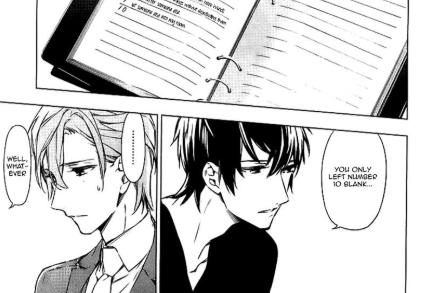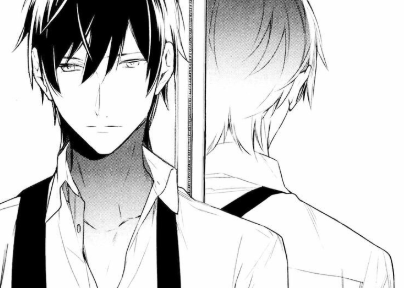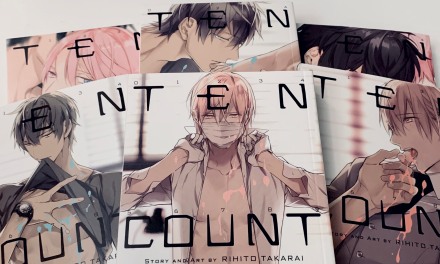A brief review of the 6-volume manga series “Ten Count,” story and art by Rihito Takarai, and licensed in English by SuBLime Manga. MINOR SPOILERS WILL BE PRESENT.
Counseled into Love
Tadaomi Shirotani suffers from extreme obsessive-compulsive disorder wherever germs are concerned. While he manages to get his corporate secretary work done efficiently enough, his social life is practically nonexistent as a result of his condition. Upon saving Shirotani’s boss from a fatal car accident, behavior therapist Riku Kurose takes an interest in helping Shirotani overcome his germophobia. As Shirotani navigates through Kurose’s proposed ten-step program designed to cure his compulsion, the patient’s attraction to his therapist grows.
As far as romance dramas go, Ten Count starts off relatively tame, especially for a BL series. In fact, there’s nothing really explicit until the end of the second volume, of which there are only six. This relatively slower-burn intro allows us to really understand the position Shirotani is in, his feelings and his frustrations with his condition. Although Shirotani’s list of ten self-chosen tasks seems like an excuse to up the sexual tension step-by-step, I assure you that the series has more twists in store than finding out what Shirotani’s final tenth step is (even if they’re a bit more controversial).
One of my favorite aspects of the series is how, foundationally, Kurose’s psychological techniques (namely the titular “ten count”) are rooted in actual behavior therapy practices. (Trust me—I took a class for this!) Exposure and response prevention therapy (ERP) is a real therapy designed to treat anxiety disorders. By gradually introducing stimuli to the patient and slowly increasing the strength of the stimulus, an individual undergoing ERP therapy can hope to see at least some relief from their OCD symptoms. It doesn’t suddenly cure all—which Rihito Takarai respectfully acknowledges—but it can help relieve some of the stresses that come with anxiety or PTSD.

The Patient-Therapist Relationship
From the start, Shirotani is a man bogged down by the pressures of society. His signature gloves may seem like a fashion choice, but they actually serve to shield his hands from potential germs. If he just wore the gloves, he’d see himself as looking foolish, though. Thus, he also dons a suit for both his job and personal life to seem less odd. I thought this was a sad detail, if not a pertinent one to telling us what kind of person Shirotani is: an extremely cautious and self-conscious individual. His condition interferes with his daily life, clearly, and he’s in dire need of help even if he refuses to admit it.
Kurose comes off as a little standoffish and weirdly intimate, and that’s also a result of a troubled past, no doubt. While he’s able to comfort Shirotani and make him feel good about himself, Kurose also has this aura of being impossible to read. For a corporate office guy with crippling OCD, this can pose major problems. Understandably, Shirotani fears the unpredictable, and even more so when it concerns human contact. What Kurose wants out of Shirotani might not be what he expects. At the same time, perhaps Kurose’s guidance and friendship are the exact things Shirotani wants out of this unconventional patient-therapist relationship.

To Fetishize Another’s Pain
Let me start this part by saying that Rihito Takari’s art is divine. Her characters are beautifully drawn, the panel construction serves to capture Shirotani’s feelings of isolation and anxiety, and the sex is hot, straight up. (I mean, Kurose’s jawline, C’MON.) Takarai also has an eye for aesthetic, her characters living clean, realistic lives, although on the lighter side. I cannot deny that reading this manga was enjoyable, if only for the art alone. It’s great. If explicit BL is your thing, Ten Count will serve you wonderfully.
Ok, now I can nitpick. SPOILERS for one of the later narrative twists, but WTF Kurose?? The dude likes—no, prefers—“people like” Shirotani because they have a germophobic condition . . . and he likes making them dirty . . . and corrupt like him?? I’m sorry, I just couldn’t with this reveal. It’s a shame, too, cause the series really started strong when it was just Shirotani meeting up with Kurose at their usual coffee shop to celebrate Shirotani’s progress.
The fetishization of mysophobia in Ten Count made the last couple volumes a struggle to get past. I really disliked finding out that, rather than love out of personality or charm, Kurose’s biggest draw to Shirotani was because of his suffering. It only confirmed my suspicions about Kurose from the beginning that the guy was a little messed up. While I appreciate the backstories for both of these characters (and can understand the effects that childhood neglect or trauma can have on someone), I couldn’t really find myself appreciating Kurose after discovering his kink.

One Step Forward, Two Steps Back
As a BL manga, Ten Count starts strong but falls into some of the unfortunate schemes of the genre that I’ve become aware of thanks to fellow bloggers and booktubers. It comes across as realistic and understanding of people with anxiety disorders, yet eventually succumbs to a somewhat insulting case of deception. I wanted Shirotani and Kurose to end up together out of a deep fondness and caring for one another, and it only feels halfway satisfying.
With any type of behavior therapy, it can often feel like you’re making leaps and strides one day, only to wake up the next feeling like you haven’t progressed past start—and that’s absolutely normal. For Shirotani, his lowest lows caused him to skip work, neglect his social life, and even turn down potential relationships. But on his best days, he stepped outside his comfort zone and took risks he normally wouldn’t have. Simply, he tried to live a better, more fulfilling life, and I can commend him for that.
Looking back, I find my liking for Ten Count to be the same way. The chapters where Kurose was genuinely trying to encourage Shirotani to go to the book store, buy a new suit, or actually drink the coffee at a coffee shop—those were great! When it just seemed like Kurose was trying to get his hands down Shirotani’s pants, however, I wasn’t quite rooting for either of them (which is kinda opposite of the intent the fanservice is supposed to do in this series).
As my first yaoi manga series, I don’t hate Ten Count, though. Rihitio Takarai’s plot has its problems, sure, but her art and character designs really are appealing. There’s a lot of self-torment going on throughout the series, but I do believe that in itself is a huge part of life. If the romantic story of a therapist and his patient sounds enticing, go ahead and give the first volume a shot. Just don’t be surprised when certain characters start revealing their true nature in the bedroom—unwonted fetishes and all.

It’s because I finally realized that I love you and you reciprocated that love that I’m learning to love myself. — Tadaomi Shirotani
Afterword
I feel I could talk at length about Ten Count, but I’m honestly not sure whether I’d be saying primarily bad things or good things. Probably a mix of both, because despite its problematic concerns with trauma and sexual arousal, I did enjoy reading about Shirotani and Kurose’s relationship (and the many, many back-and-forth turns it takes). I know this series stirred a lot of buzz when it was first brought over in 2018, but what are your thoughts on Ten Count? For my first yaoi manga series, I feel like I picked a decent one, but you be the judge of that.
I’ll pass Ten Count as a “Cake” title here at the cafe if only for the fact that Shirotani’s story is fleshed out in a lovely six volumes and not just two or three. If you’ve got any BL recommendations, I’d also love to hear those. I’ve got more Pride Month content coming soon, so if BL is your thing, you’re in luck! Thanks for reading, and ’till next time!
– Takuto

